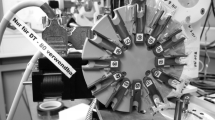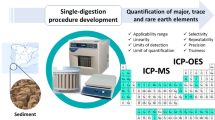Abstract
Precise and accurate determination of hexavalent chromium in different types of solid environmental sample is regarded as a technical challenge with significant potential error if historically accepted methods are used. Microwave-assisted alkaline extraction (0.5 mol L−1 NaOH+0.28 mol L−1 Na2CO3) followed by anion-exchange chromatographic separation and inductively coupled plasma mass spectrophotometric detection has been shown to provide accurate and precise results. To obtain a better understanding of potential species conversion during and/or after extraction steps, speciated isotope-dilution mass spectrometry (SIDMS) (EPA Method 6800) metrology has been successfully applied as a diagnostic tool with the modified accompanying extraction version of EPA Method 3060A. In our study, aggregate materials distributed over a large area of a major western US state were found to contain a high concentration of total chromium (195±13 to 709±19 μg g−1) and significant amounts of Cr6+ (141±6 to 341±29 μg g−1) which are at least three orders of magnitude higher than the US EPA threshold limit (0.5 μg g−1). Sediment samples from a major western US state, studied independently, were found to contain less (1.77±0.34 μg g−1) or no Cr6+ in the presence of significant total chromium.




Similar content being viewed by others
References
Li Y, Pradhan NK, Foley R, Low GKC (2002) Talanta 57(6):1143–1153
Wang J, Ashley K, Kennedy ER, Neumeister C (1997) Analyst 122(11):1307–1312
Marques MJ, Salvador A, Morales-Rubio AE, de la Guardia M (1998) Fresenius J Anal Chem 362(3):239–248
Ndung’u K, Djane N-K, Malcus F, Mathiasson L (1999) Analyst 124(9):1367–1372
Nriagu JO, Nieboer E (eds) (1988) Advances in environmental science and technology (vol 20: Chromium in the natural and human environments). Wiley, New York
Weckhuysen BM, Wachs IE, Schoonheydt RA (1996) Chem Rev 96(8):3327–3349
Vitale RJ, Mussoline GR, Rinehimer KA, Petura JC, James BR (1997) Environ Sci Technol 31(2):390–394
Vitale RJ, Mussoline GR, Petura JC, James BR (1994) J Environ Qual 23(6):1249–1256
Flores-Velez LM, Gutierrez-Ruiz ME, Reyes-Salas O, Cram-Heydrich S, Baeza-Reyes A (1995) Int J Environ Anal Chem 61(3):177–187
Prokisch J, Kovacs B, Gyori Z, Loch J (1995) Commun Soil Sci Plant Anal 26(13–14):2051–2065
Prokisch J, Kovacs B, Gyori Z, Loch J (1994) J Chromatogr A 683(1):253–260
Sabty-Daily RA, Luk KK, Froines JR (2002) Analyst 127(6):852–858
Luque-Garcia JL, Luque de Castro MD (2002) Analyst 127(8):1115–1120
Foy GP, Pacey GE (2000) Talanta 51(2):339–347
USEPA (1996) Method 3060A, alkaline digestion for hexavalent chromium. Tests methods for evaluating solid waste, physical/chemical methods SW 846, US Government Printing Office (GPO): Washington, DC
Rao TP, Karthikeyan S, Vijayalekshmy B, Iyer CSP (1998) Anal Chim Acta 369(1–2):69–77
Tirez K, Brusten W, Cluyts A, Patyn J, De Brucker N (2003) J Anal At Spectrom 18:922–932
USEPA (2004) Method 6800, elemental and speciated isotope-dilution mass spectrometry, tests methods for evaluating solid waste, physical/chemical methods SW 846, Update IVA. US Government Printing Office (GPO), Washington, DC
USEPA (2004) Draft Method 3200, Mercury species separation by selective solvent extraction and acid digestion. US Government Printing Office (GPO), Washington, DC
Federal Register (1998) 63(89):25430–25438
Kingston HM (1995) US Patent 5:414–259
Kingston HM (2004) US Patent 6:790–673B1
Huo D, Kingston HM (2000) Anal Chem 72(20):5047–5054
Kingston HM, Huo D, Lu Y, Chalk S (1998) Spectrochim Acta Part B 53(2):299–309
Huo D, Lu Y, Kingston HM (1998) Environ Sci Technol 32(21):3418
Huo D (1999) PhD Thesis. Duquesne University, Pittsburgh, PA, USA
Caruso JA, Sutton KL, Ackley KL (2000) Comprehensive analytical chemistry, Chap. 10 (Elemental speciation: new approaches for trace element analysis, vol 33) (eds). Elsevier, New York
Kingston HM, Huo D, Rahman GMM, Iyer S, Walter P (2004) SamplePrep Web, Available: http://www.sampleprep.duq.edu/
Rahman GMM, Kingston HMS (2004) Anal Chem 76(13):3548–3555
USEPA (1996) Method 3052, microwave assisted acid digestion of siliceous and organically based matrices, tests methods for evaluating solid waste, physical/chemical methods SW 846. US Government Printing Office (GPO), Washington, DC
Marques MJ, Salvador A, Morales-Rubio A, de la Guardia M (2000) Fresenius J Anal Chem 367(7):601–613
James BR, Petura JC, Vitale RJ, Mussoline GR (1995) Environ Sci Technol 29(9):2377–2381
Kingston HM, Haswell SJ (1997) Microwave enhanced chemistry: fundamentals, sample preparation, and applications ACS professional reference book series. American Chemical Society, Washington, DC, pp 223–349
Rudel H, Terytze K (1999) Chemosphere 39(4):697–708
Taylor HE (2001) Inductively coupled plasma-mass spectrometry: practices and techniques. Academic, San Diego, p 48
Elemental VG (1989) VG plasmaquad system manual. VG Elemental Ltd, Winsford, England
Jarvis KE, Gray AL, Houk RS (1992) Handbook of inductively coupled plasma mass spectrometry. Blackie Academic& Professional, London, p 315
Acknowledgements
The authors would like to thank Environmental Standards Inc. and the Department of Chemistry and Biochemistry, Duquesne University, for funding and financial support, and Milestone Inc., Agilent Technologies Inc., and Duquesne University for instrumentation and material support. Portions of the methodology in this paper are patented and/or patent pending.
Author information
Authors and Affiliations
Corresponding author
Rights and permissions
About this article
Cite this article
Rahman, G.M.M., Kingston, H.M.S., Towns, T.G. et al. Determination of hexavalent chromium by using speciated isotope-dilution mass spectrometry after microwave speciated extraction of environmental and other solid materials. Anal Bioanal Chem 382, 1111–1120 (2005). https://doi.org/10.1007/s00216-005-3203-7
Received:
Revised:
Accepted:
Published:
Issue Date:
DOI: https://doi.org/10.1007/s00216-005-3203-7




